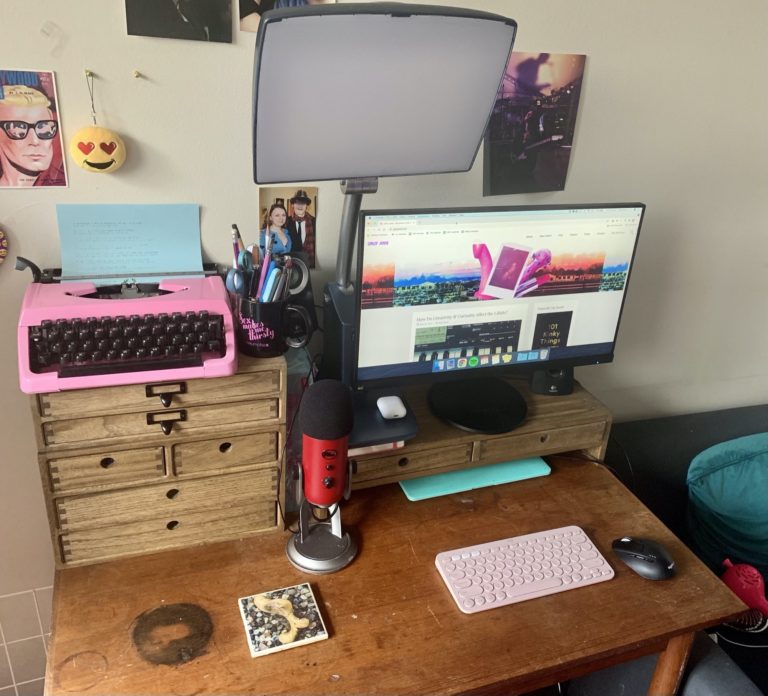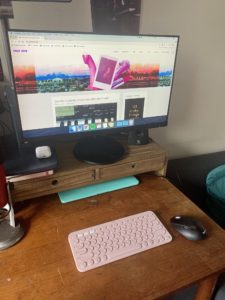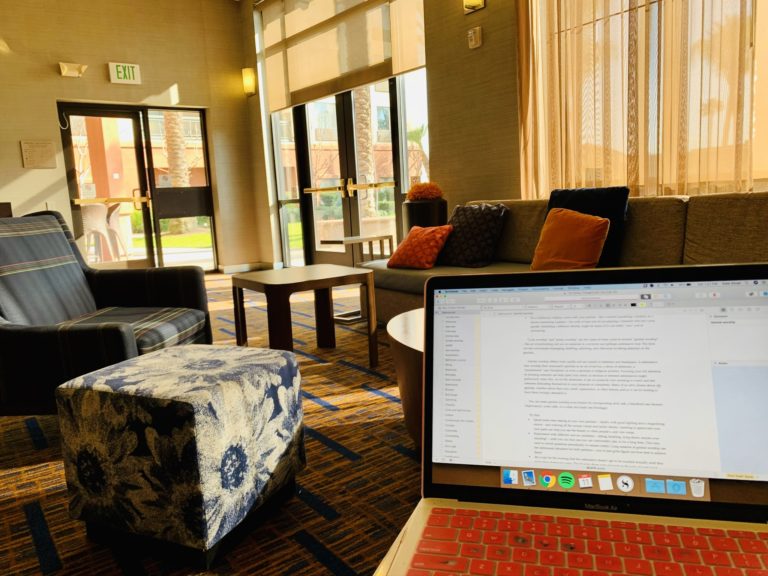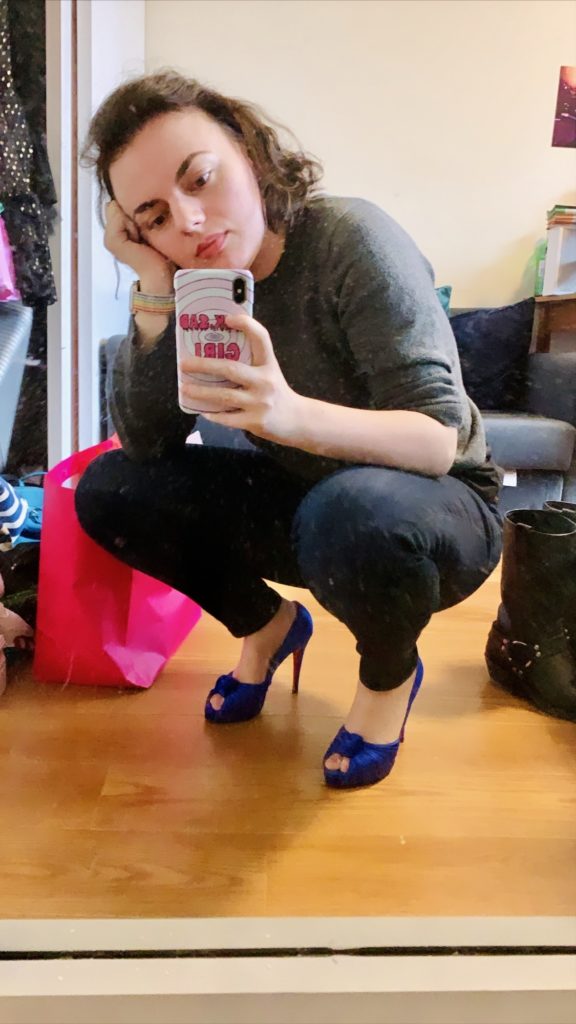
Writers can debate endlessly about whether the space where you choose to work, and the tools you use to do that work, actually matter. Some writers can throw their laptop in a tote bag and take it to a café, or the library, or a random picnic table in the park, and create masterworks; others need their perfectly-appointed desk with just the right mood lighting, soundtrack, and assortment of artisanal pencils if they’re going to produce their best work.
I can go either way, but that’s partly because I’ve rarely had an actually-functional workspace in my life. A blend of depression, body pain, and chronic disorganization has often led me to clutter up desks and tables with useless tchotchkes and accumulated trash, choosing instead to work in bed or (in pre-pandemic times) at cafés and bars. I always wanted to have a more settled, organized workspace, but rarely got my shit together enough to actually make it happen.
Earlier this year, for my birthday, a few different friends and family members very generously got me gift cards aimed at helping me update my workspace, because I’d mentioned wishing I could do that. Wanting to put their gifts to good use, I started brainstorming what I wanted and needed to make my vintage, worse-for-wear wooden desk into an oasis of creativity. Here are some of the things I bought to spruce the place up…
 • Since one of my main issues was constantly having too many random objects all over my desk, I decided storage was a top priority. My desk has two built-in drawers, one of which I use for weed stuff + incense and the other of which I use to store logistical necessities like Scotch tape, loose change, and my passport – but everything else needed a place to go. So I bought an assortment of stackable wooden drawers from Kirigen, and a matching monitor riser that also has a couple of drawers in it. These have already made a HUGE difference for me. Some of the stuff I store in these drawers: pens, pencils, extra batteries, extra pairs of glasses, documents, cards/letters/notes, notepads and notebooks, index cards, spare sets of earbuds, cheques I need to cash, and an occasional snack.
• Since one of my main issues was constantly having too many random objects all over my desk, I decided storage was a top priority. My desk has two built-in drawers, one of which I use for weed stuff + incense and the other of which I use to store logistical necessities like Scotch tape, loose change, and my passport – but everything else needed a place to go. So I bought an assortment of stackable wooden drawers from Kirigen, and a matching monitor riser that also has a couple of drawers in it. These have already made a HUGE difference for me. Some of the stuff I store in these drawers: pens, pencils, extra batteries, extra pairs of glasses, documents, cards/letters/notes, notepads and notebooks, index cards, spare sets of earbuds, cheques I need to cash, and an occasional snack.
• Buying my new monitor was a JOURNEY! I wanted a specific 24″ ViewSonic monitor (the VX2485-MHU model) because the Wirecutter had recommended it as one of the best budget monitors they’d tried, and because it has a USB-C port, allowing me to connect my MacBook Air to the display and charge it with just one cable. I ordered a pre-owned one from an online seller, but it got lost in the mail somehow, so they refunded me. Then I saw a new version of the same monitor on a semi-sketchy retail site and asked Staples if they could price-match it, which they agreed to do. But 2 weeks after I’d already placed my order through Staples, they told me the monitor was actually out of stock, and cancelled my order. So I ordered it from yet another store, and it finally arrived. I’m glad I managed to acquire this one – it looks pretty damn good for being a $300 monitor, and fits nicely in the space allotted for it.
• One of the bulkiest items on my desk, pre-makeover, was my Day-Light SAD lamp. It was a must-have for my depression, especially in the winter, but I’d had that particular model since 2007 (!!) and knew there were some less cumbersome options on the market now. I arranged to give my old lamp away to someone from a local mental health support group who needed one, and then bought this new one, the Day-Light Sky. It takes up way less desk space, and I love that its angle is adjustable. I currently have it sitting atop a small stack of hardcover notebooks, to give the computer monitor enough space to fit neatly underneath.
 • I told you about this keyboard when I showed you my working-from-bed setup. Still loving it! It’s the Logitech K380. I adore its sweet pink hue, softly clicky-clacky keys, and ability to swap between up to 3 different devices as needed, so I can move from my computer on the desk to my iPad in bed with ease.
• I told you about this keyboard when I showed you my working-from-bed setup. Still loving it! It’s the Logitech K380. I adore its sweet pink hue, softly clicky-clacky keys, and ability to swap between up to 3 different devices as needed, so I can move from my computer on the desk to my iPad in bed with ease.
• My mouse is the Logitech M720, which is also great. I’m considering switching to an Apple Magic Trackpad, though, because after years of using a trackpad instead of a mouse, I find them much more intuitive now. But this mouse is lovely, as far as mice go.
• My spouse bought me a beautiful vintage pink Brother typewriter as a gift after we watched the movie California Typewriter together. It’s mostly a decorative item because I lack the hand strength required to really hammer out any substantial pieces of writing on it – plus I worry about annoying my roommate with the loud typing – but I love having it displayed on my desk. It’s such a gorgeous symbol of my writerly ambitions and achievements, and I enjoy occasionally banging out a poem or two on its snappy black keys.
• A while ago, my friend Thomas sent me a spinning desk toy called a Mezmoglobe, and that’s sitting underneath my monitor riser where I can periodically spin it and admire its gleaming prettiness throughout the day.
• While it isn’t new, I do want to mention that my coaster was a gift from Penny, who is an incredible photographer and used to make these adorable sex toy photo coasters. This one features a picture of the NobEssence Romp, easily the prettiest butt plug I’ve ever owned. I use it every day for water, coffee, cocktails, or whatever else I happen to be drinking while I write.
Things I’d still like to acquire for my setup:
• A webcam. I used to just use my laptop’s built-in webcam for Zoom calls, video podcast recordings, etc. but that’s less convenient now that I keep it tucked under my monitor riser. I’m hoping to pick up a Logitech C920S on the Wirecutter’s recommendation. It’ll sit nicely on top of my monitor and make all my video calls and livestreams look way better.
• A better system for getting my microphone and headphones out of the way when I’m not using them – like maybe a boom arm.
• A better desk chair. Right now I’m still using the blue faux-leather one my dad bought me for about $50 at Staples when I was in university, and it’s really seen better days. I’m considering getting an Albin task chair from Wayfair. It’s surprisingly hard to find an armless chair that’s slim enough for the space under my desk, ergonomic enough for my chronically achy body, and costs less than a zillion dollars!
What workspace essentials are you loving lately?



 Sundays are the most anxiety-provoking day of the week for many people. For those of us with a standard Monday-to-Friday work week (which is, itself, a privilege in many ways), pre-emptive Monday nerves can sneak into Sunday and turn it from a relaxed respite into pins-and-needles panic. It doesn’t have to be this way!
Sundays are the most anxiety-provoking day of the week for many people. For those of us with a standard Monday-to-Friday work week (which is, itself, a privilege in many ways), pre-emptive Monday nerves can sneak into Sunday and turn it from a relaxed respite into pins-and-needles panic. It doesn’t have to be this way!